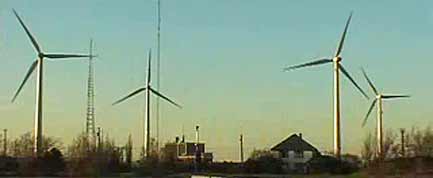Wind Farms Could Change Weather

A new study suggests that massive wind farms could steer storms and alter the weather if extensive fields of turbines were built, according to a news report.
It is not the first study to come to this conclusion.
The new research is an interesting "what if," but the installation of large wind turbines would have to be taken to the extreme to have the global effects portrayed.
The scientists, Daniel Barrie and Daniel Kirk-Davidoff of the University of Maryland, calculated "what might happen if all the land from Texas to central Canada, and from the Great Lakes to the Rocky Mountains, were covered in one massive wind farm," according to Discovery News. The result of such an unlikely installation: a real serious Butterfly Effect.
Such massive wind farming would slow wind speeds by 5 or 6 mph as the turbines literally stole wind from the air. A ripple effect would occur in the form of waves radiating across the Northern Hemisphere that could, days later, run into storms and alter their courses by hundreds of miles.
The researchers "acknowledged the hypothetical wind farm was far larger than anything humans are likely to build," according to the Web site, but if Department of Energy projections for wind farming are met by 2030 (for the country to get 20 percent of its electricity from wind), "it could probably have an effect," James McCaa of 3Tier, Inc., a renewable energy forecasting company based in Seattle, is quoted as saying.
In 2004, two separate groups of scientists did similar calculations.
Sign up for the Live Science daily newsletter now
Get the world’s most fascinating discoveries delivered straight to your inbox.
One group found the opposite effect.
Somnath Baidya Roy of Princeton University and colleagues simulated the effect of extensive wind farms on local weather. They found a drying and warming effect in the morning that would warm the air across moist and cool overnight soil, causing the local wind speed to increase slightly.
Also in 2004, David Keith of the University of Calgary and his colleagues estimated the drag from wind farms if they covered 10 percent of the Earth's land surface. They concluded that global cooling would occur in polar regions and global warming would result in temperate regions such as North America at about 30 degrees North latitude.
When that study was released, Keith had an interesting take on the possibility: "The message here is climate change, but that doesn't equal global warming," Keith said. "It's possible this would have benefits," by working against the atmospheric effects of fossil fuel consumption on global climate, he said.
- The Energy Debates: Wind Farms
- Top 10 Emerging Environmental Technologies
- Video: Wind Power From Thin Air
This article is from the LiveScience Water Cooler: What people are talking about in the world of science and beyond.
Robert is an independent health and science journalist and writer based in Phoenix, Arizona. He is a former editor-in-chief of Live Science with over 20 years of experience as a reporter and editor. He has worked on websites such as Space.com and Tom's Guide, and is a contributor on Medium, covering how we age and how to optimize the mind and body through time. He has a journalism degree from Humboldt State University in California.










